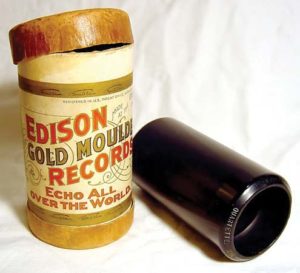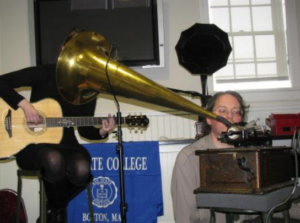Audio Technology: A Look Back at the Edison Wax Cylinder
[February 2012] Disc jockeys often used the phrase “stacks of wax” to describe their library. The term relates back to when wax was truly the recording media. A recent recording session hosted by the Audio Engineering Society showed not just that it could still be done, but gave a unique opportunity to experience the results.
Long relegated to the pages of audio obsolescence, Thomas Edison’s Wax Cylinders actually were the first popular format for music (and spoken word) distribution.
Edison’s invention along with variations from other makers – including improved hard wax coatings like carnauba, which replaced paraffin and beeswax – thrived from 1878 until 1909 when flat discs took over – although the format continued to be used as the basis for the dictation machines that were used by many businesses. (The cylinders could be “erased” and reused by “shaving” the wax coating!)

In fact, these cylinders were the initial link in an evolutionary chain that has stretched over 130 years from using wax to lacquer LPs to vinyl 45 RPM singles to 8-track tapes and ending – as of today – with digital files, including MP3s and CDs.
Of course, in the late 1870s, Edison was more concerned with being able to store and replay audio than having the ultimate in bandwidth and fidelity. A testament to the popularity of Edison cylinders can be found to this day among the thousands of cylinders in some collections – truly “stacks of wax” that allow students of audio recording history to hear voice and music recorded well over a century ago.
Blast from the Past
However, earlier this month a group of college students and faculty members got to see a real Edison recorder and player in action, producing state-of-the-art audio – circa 1878.
The group of 30 or so were guests at a special event in West Orange, NY on February 10th , where a live performance was co-hosted and staged at the Thomas Edison National Historical Park by Audio Engineering Society (AES) members John Krivit and David Bialik. Guest performer Suzanne Vega provided the material to be recorded.
Krivit, who is the AES Education Committee Chairman, noted they had made such demonstrations before. He said “… they’ve proved an excellent way to illustrate the creative relationship between physical science and recording.“
Interestingly the performer and her song have a special place in audio history of their own. As Krivit explained: “It’s not coincidental that Ms. Vega performed her iconic Tom’s Diner hit for our demo. Her original 1987 a capella version was used as a reference standard by audio engineering innovator (and AES member), Karlheinz Brandenburg in his development of the mp3 process.”
Live on Wax
To emulate the original process, Vega literally put her head into the horn which served as the microphone and loudspeaker.

The event was videotaped by CBS Interactive. You can watch the recording process and hear the resulting audio – exactly as it would have sounded in 1878 – at this link. A longer video with some narration and explanation of the event is located here. Courtesy: CBS Interactive The horn was microphone and speaker
Preservation
A few Edison cylinder machines and quite a few cylinders have survived, although the organic wax has deteriorated in many cases, including where mold had grown on cylinders which were stored in a humid environment.
The Edison Museum, historians and other collectors continue to seek and preserve these early recordings. Efforts include using a variety of pickup methods from Shure styli to specialized microscopes to produce analog audio and digital files from the cylinders.
Among the larger collections is at the University of California, Santa Barbara, which currently has more than 8,000 cylinders in the UCSB digital library, available for download by those interested.
– – –
The Audio Engineering Society was formed in 1948 by a group of concerned audio engineers and now counts over 14,000 members around the world.
The organization serves as the pivotal force in the exchange and dissemination of technical information for the industry. For additional information visit http://www.aes.org.
– – –
Are articles like this helpful to you? If so, you are invited to sign up for the one-time-a-week.BDR Newsletter.
It takes only 30 seconds by clicking here.
– – –
